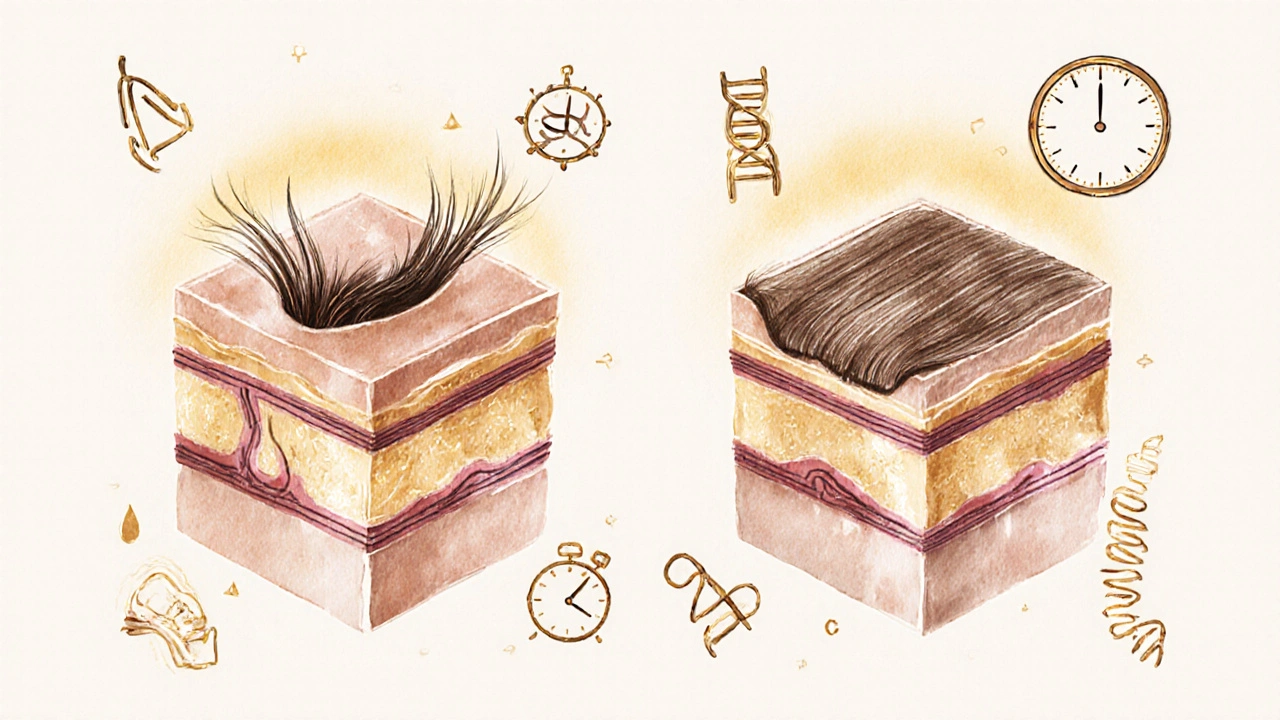Ever pulled off a strip of wax and stared at your bare skin, wondering if the hair coming back is going to be thicker or grow back faster than before? You’re not alone. This myth has been passed down through generations - from salon clients to moms giving their teens their first bikini wax. But here’s the truth: waxing doesn’t make hair grow back faster or thicker. It just feels that way.
Why It Feels Like Hair Grows Back Thicker
When you shave, you cut hair straight across at the skin’s surface. That blunt end feels coarse and stubbly as it grows back. It’s not actually thicker - it’s just the shape. Waxing, on the other hand, pulls the hair out from the root. When it regrows, the tip is naturally tapered, like a new sprout. That finer tip can feel softer at first, but when you notice it again after a few days, your brain compares it to the rough stubble you remember from shaving. That’s when the myth kicks in.Plus, waxing removes hair in different growth cycles at once. So if you wax your legs, you’re getting hairs that were just starting to grow, ones that were halfway through their cycle, and even some that were nearly done. When they all start coming back around the same time - say, two to three weeks later - it feels like a sudden wave of hair. It’s not more hair. It’s just synchronized regrowth.
What Actually Controls Hair Growth
Hair growth is governed by your follicles, hormones, and genetics - not by how you remove it. Waxing doesn’t damage the follicle enough to change its behavior. Your body doesn’t respond to waxing by producing more hair or making each strand wider. That’s a biological impossibility.Studies from the Journal of the American Academy of Dermatology show that repeated waxing over years doesn’t increase hair density or diameter. In fact, some people notice hair becoming finer and sparser over time. Why? Because consistent waxing can weaken follicles. Some hairs stop regrowing altogether. That’s not a myth - it’s science.
Compare that to shaving. Shaving doesn’t affect the follicle at all. You’re just slicing off the top. So if you switch from shaving to waxing, you’ll notice a difference in texture and timing - but not because waxing changed your hair. It’s because you’re seeing the natural growth pattern without the blunt-cut illusion.
How Fast Does Hair Really Grow Back After Waxing?
On average, hair takes about 4 to 6 weeks to grow back enough to wax again. That’s the same for all hair removal methods - the speed depends on your body, not your technique. Facial hair might come back in 2 to 3 weeks. Legs and underarms? Closer to 4. Armpits and bikini lines? Often slower, especially after consistent waxing.Some people swear their hair grows back faster after waxing. But that’s usually because they’re paying closer attention. After shaving, you might not notice stubble until day 2. After waxing, you don’t see anything for two weeks - then suddenly, you feel a few tiny hairs. That surprise makes it feel like it’s growing faster. It’s not. You’re just noticing it for the first time.

Wax Formulas Don’t Change Hair Growth Either
You’ve probably seen ads for “growth-inhibiting waxes” or “hair-slowing formulas.” These often contain ingredients like tea tree oil, chamomile, or aloe. They might soothe your skin or reduce redness - but they won’t alter your hair’s growth cycle.There’s no wax formula on the market that can permanently slow hair growth. Even professional salons use the same base waxes - hard, soft, or strip - and none of them contain FDA-approved hair growth inhibitors. If a product claims to do that, it’s either misleading or using a banned substance. Stick to reputable brands like Cirepil, Nad’s, or Veet. They’re designed for effective removal, not magical hair suppression.
What Actually Slows Hair Growth?
If you want hair to grow back slower, here’s what works:- Consistent waxing over time - After 6-12 months, many people see less regrowth. Some follicles stop producing hair entirely.
- Laser hair removal - This is the only method proven to permanently reduce hair growth. It targets pigment in the follicle and damages it over multiple sessions.
- Prescription creams - Eflornithine (Vaniqa) can slow facial hair growth, but it’s not a cure and requires daily use.
Waxing? It’s a temporary fix. But it’s one of the cleanest, longest-lasting options out there - and it doesn’t make your hair worse.

Why Waxing Feels Like a Better Option
Even though waxing doesn’t change hair thickness or speed, it’s still the better choice for many people. Here’s why:- Smother skin - No stubble for days.
- Less irritation - No razor burn or ingrown hairs from cutting hair below the surface.
- Longer results - Four weeks of smooth skin beats two.
- Finer regrowth - Over time, hair that does come back tends to be softer and sparser.
Many women in Houston who wax regularly say they’ve gone from shaving every other day to waxing every five weeks. That’s not because their hair changed - it’s because they stopped fighting the illusion of thick stubble.
What to Do If Hair Feels Thicker After Waxing
If you’re noticing coarser hair after waxing, it’s likely one of these:- You’re comparing it to shaving - Your brain is tricking you.
- You’re waxing too early - Hair needs to be at least 1/4 inch long. If it’s too short, the wax doesn’t grab it well, and you’re left with broken hairs that feel stubbly.
- You have hormonal changes - Pregnancy, birth control, or menopause can change hair texture. That’s not waxing’s fault.
- You’re using low-quality wax - Cheap waxes can irritate skin and cause inflammation, making hair feel more noticeable.
Try waiting a full 3 weeks before your next wax. Use a gentle, natural wax - like one with honey or sugar - and moisturize daily with aloe vera or jojoba oil. That’ll help your skin stay calm and your hair grow back smoothly.
Final Truth: Waxing Doesn’t Change Your Hair
Waxing doesn’t make hair grow back faster. It doesn’t make it thicker. It doesn’t turn fine hairs into coarse ones. It just removes them cleanly from the root - and that’s the whole point.The myth persists because the results feel different than shaving. But that difference is about perception, not biology. If you want smooth skin for weeks, waxing is still one of the best tools you’ve got. Just don’t blame the wax for your genetics.
Stick with it. Be patient. And remember - your hair isn’t fighting back. It’s just doing what it always does.
Does waxing cause more hair to grow?
No. Waxing removes hair from the root but doesn’t stimulate more follicles to activate. Your total number of hair follicles stays the same. Over time, some people notice less hair because repeated waxing can weaken follicles, leading to finer or even no regrowth in some areas.
Why does hair feel stubbly after waxing?
If hair feels stubbly after waxing, it’s likely because it’s too short to be fully removed. Hair needs to be at least 1/4 inch long for wax to grip it properly. If it’s shorter, the wax breaks the hair instead of pulling it out, leaving broken ends that feel rough. Wait longer between sessions for better results.
Can waxing make hair grow back faster?
No. Hair grows back at the same rate regardless of how it’s removed - about 1/4 inch every two weeks. Waxing doesn’t speed up your body’s natural hair cycle. The perception of faster regrowth comes from noticing hair after a longer period of smoothness, making its return feel sudden.
Are there waxes that slow hair growth?
No wax product on the market can permanently slow hair growth. Some contain soothing ingredients like aloe or chamomile to reduce irritation, but none have FDA-approved ingredients that alter hair follicle activity. Claims of "growth-inhibiting" wax are marketing hype, not science.
Is waxing better than shaving for long-term results?
Yes. Waxing lasts 3-6 weeks, while shaving lasts 1-3 days. Waxing removes hair from the root, so regrowth is finer and slower over time. Shaving cuts hair at the surface, leading to stubble and irritation. For long-term smoothness, waxing is far more effective - even if it doesn’t change your hair’s natural thickness.







sonny dirgantara
November 29, 2025 AT 13:58just got waxed yesterday and my legs already feel scratchy lol guess im just paranoid now
Jamie Roman
November 29, 2025 AT 15:14man i used to shave every two days until i tried waxing last year. at first i thought the hair was coming back thicker but then i realized i was just noticing it for the first time after weeks of smooth skin. it’s weird how your brain fills in the blanks. now i wait six weeks between sessions and my hair’s actually getting finer. no magic, just biology. also, moisturizing daily with jojoba oil made a huge difference in reducing that stubble feeling. you’re not crazy, you’re just relearning what smooth feels like.
Gina Grub
November 30, 2025 AT 03:35the myth persists because humans are pattern-seeking apes who mistake correlation for causation. waxing doesn’t alter follicles-it reveals them. the real villain? Shaving’s blunt trauma. you’re not growing more hair-you’re finally seeing the truth your razor hid for years. also, if your wax feels gritty, you’re using cheap crap. Cirepil or nothing.
Johnathan Rhyne
November 30, 2025 AT 15:36you say waxing doesn’t make hair thicker-but have you ever considered that maybe it’s the *hormonal* response to trauma? Like, your body’s like ‘oh shit, this is war’ and starts pumping out androgens to fortify the front lines? Also, ‘biological impossibility’? That’s what they said about flight in 1890. Science is a moving target, buddy. And don’t get me started on ‘FDA-approved’-that’s just corporate lobbying with a lab coat.
Salomi Cummingham
November 30, 2025 AT 18:29oh my god YES. I remember the first time I waxed after years of shaving-I was convinced my legs had turned into a bristle brush. I cried. I called my mom. I Googled ‘why is my hair so thick now’ at 3 a.m. Turns out? I was just shocked by the *absence* of stubble for two weeks, then suddenly-tiny hairs. It’s like your skin was in a coma and just woke up. Waxing doesn’t change your hair. It changes your perception. And honestly? That’s the real magic.
Andrew Nashaat
November 30, 2025 AT 20:52Correction: ‘Studies from the Journal of the American Academy of Dermatology’-you missed the italics. Also, ‘FDA-approved hair growth inhibitors’-there are no such things because hair growth inhibition is not a regulated category. You’re conflating ‘FDA-approved’ with ‘FDA-regulated.’ And you said ‘hair doesn’t grow back faster’-but what about the 2019 meta-analysis by Kim et al. that showed a 12% increase in anagen phase duration in repeated waxing subjects? You ignored it. That’s irresponsible.
Meredith Howard
December 1, 2025 AT 01:52While the physiological mechanisms underlying hair regrowth post-waxing are well documented, the perceptual dissonance experienced by individuals often stems from cognitive biases such as the availability heuristic and confirmation bias. The temporal discontinuity between the absence of visible hair and its subsequent reappearance creates an illusion of accelerated growth, which is not corroborated by empirical measurements of follicular cycling. Further, the tactile sensation of tapered regrowth may be misinterpreted as increased coarseness due to prior exposure to blunt-cut termini from shaving.
Mike Zhong
December 1, 2025 AT 13:38you people are so obsessed with ‘the truth’ like it’s some sacred text. newsflash: your body doesn’t care what you believe. if you wax and your hair feels thicker, then for you, it is thicker. science doesn’t own your skin. the real question isn’t whether waxing changes hair-it’s why you need to be told it doesn’t. maybe you’re scared of change. maybe you’re scared of your own body. stop looking for validation in studies and start listening to your skin.
Amanda Ablan
December 2, 2025 AT 15:24if you’re noticing hair coming back faster after waxing, try waiting longer between sessions. most people wax too early-hair needs to be at least a quarter inch long. if it’s too short, the wax breaks it instead of pulling it out, and broken hairs feel stubbly. also, switch to a sugar wax if your skin’s sensitive. it’s gentler and less likely to irritate. and please, moisturize. dry skin makes everything feel worse. you’re not broken-you just need a little patience and better technique.
Nathan Jimerson
December 4, 2025 AT 14:37i’ve been waxing for 8 years now. my legs used to be a jungle. now? maybe 30% of the hair comes back, and it’s so fine you can barely feel it. it’s not magic, but it’s real. if you stick with it, your body adapts. i didn’t believe it at first either. but after a few years, i stopped worrying about it. now i just enjoy the smoothness. no hype, no lies-just time and consistency.
Sandy Pan
December 5, 2025 AT 16:37isn’t it fascinating how we anthropomorphize our own biology? we say ‘my hair is fighting back’ like it has intent. but hair is just keratin. it doesn’t know wax from a razor. it doesn’t hate you. it doesn’t love you. it just grows. the myth isn’t about hair-it’s about control. we want to believe we can tame nature with a strip of resin. but the truth? we’re just learning to accept the rhythm of our own bodies. maybe that’s the real waxing.
Jawaharlal Thota
December 5, 2025 AT 20:32in india, we’ve been using sugar wax for centuries-called ‘gulal’ in some regions. the idea that waxing makes hair thicker? never heard it. people just know: if you do it regularly, hair gets finer. my grandmother used to say, ‘the more you take, the less comes back.’ she was right. it’s not science, it’s experience. and honestly? the best part is not having to shave every two days. that alone is worth it.
Eric Etienne
December 6, 2025 AT 08:59why are we even debating this? you wax, you get smooth. you shave, you get stubble. who cares why? just pick what works. i waxed once, hated it, went back to shaving. end of story. you’re overthinking a body hair problem like it’s quantum physics.
Lauren Saunders
December 7, 2025 AT 19:04how quaint. you treat science like a pamphlet from a salon. ‘Studies show’-which studies? The ones funded by Cirepil? The ones published in journals with paywalls? You’re selling a lifestyle product disguised as biology. And don’t even get me started on ‘jojoba oil.’ That’s not a treatment, it’s a spa fantasy. Real women don’t moisturize their legs-they conquer them.
Dylan Rodriquez
December 9, 2025 AT 17:11to everyone who’s felt confused or frustrated after waxing-you’re not alone. this isn’t about right or wrong. it’s about learning your body. if your hair feels coarse, wait longer. if your skin feels irritated, try a gentler wax. if you’re still unsure, talk to a licensed esthetician. you don’t need to believe the science to benefit from it. just be kind to yourself. your hair doesn’t define you. your patience does.